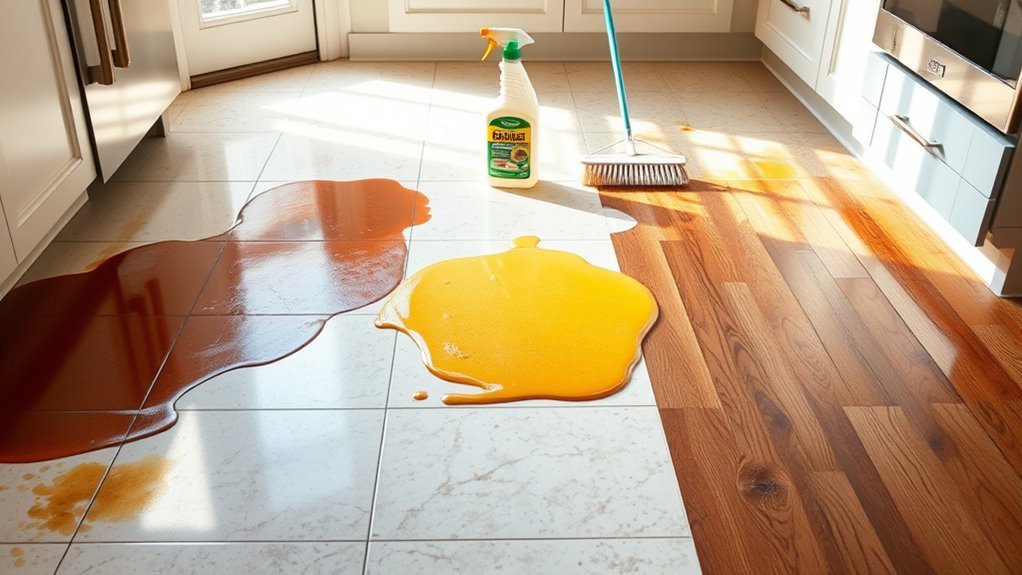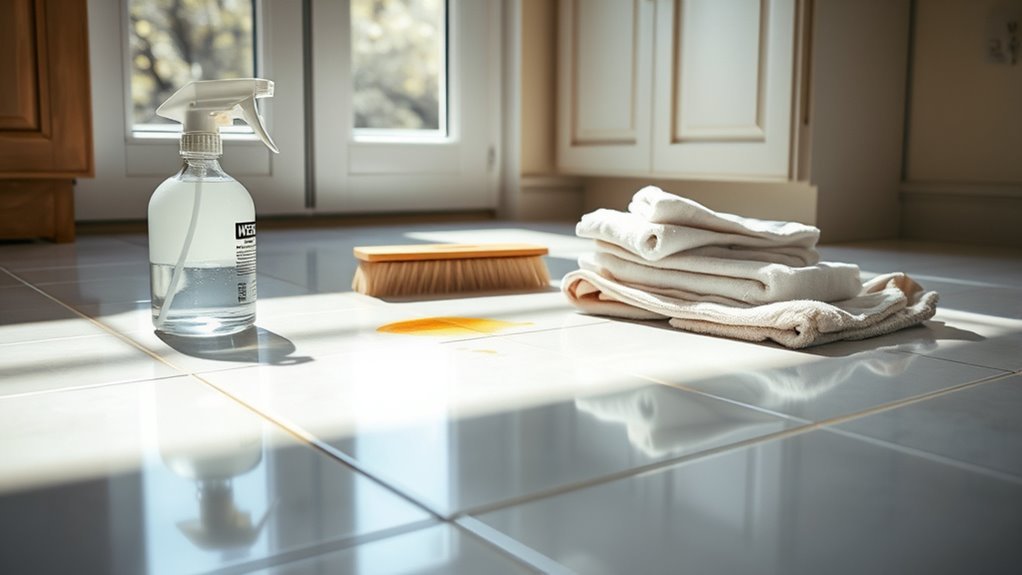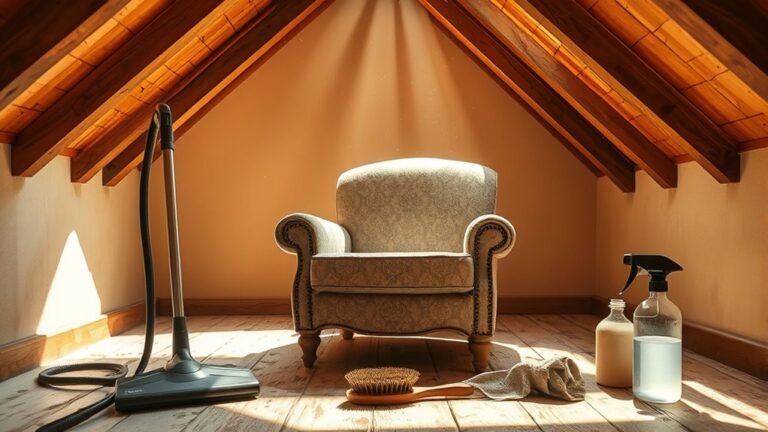How to Clean Grease Floors
To clean grease floors effectively, first identify your floor type and the grease source, then gather essential tools like scrub brushes, microfiber cloths, and a bucket of warm water. Use a suitable degreaser—natural options like vinegar or commercial products based on your preference—and apply it evenly. Scrub gently or vigorously as needed, rinse thoroughly, and dry completely. Wearing gloves and ventilating the area is vital for safety. Keep going to discover more tips on preventing buildup and optimizing your cleaning routine.
Identifying the Type of Grease and Floor Surface

Before you start cleaning, it’s important to identify what kind of grease you’re dealing with and the type of floor surface you have. Different grease types—like cooking oil, motor oil, or industrial lubricants—react differently to cleaning methods. Knowing this helps you avoid damage and guarantees effective removal. Likewise, floor materials matter; tile, concrete, hardwood, and vinyl each require tailored care. For instance, harsh chemicals might ruin hardwood but work fine on concrete. By understanding these variables upfront, you gain control over the cleaning process, freeing yourself from guesswork and potential mistakes. Once you recognize the grease type and floor material, you can confidently choose the best approach that respects your floor’s integrity and your desire for a clean, unrestricted space.
Essential Tools and Cleaning Supplies
To tackle greasy floors effectively, you’ll need the right tools and cleaning supplies. This includes sturdy scrub brushes, strong degreasing agents, and protective gear like gloves and goggles. Getting these essentials ready will make the job safer and much easier.
Must-Have Cleaning Tools
Although tackling grease floors can seem intimidating, having the right tools makes the job much easier. To maintain your freedom from stubborn stains, equip yourself with a sturdy mop or microfiber cloth for versatile cleaning techniques. A scrub brush with firm bristles helps you target tough grease without damaging sensitive floor materials like wood or tile. Don’t forget a bucket for warm water and a squeegee to remove excess liquid quickly. Gloves protect your hands, letting you work confidently without hesitation. Choosing tools designed to match your floor materials guarantees effective results without unnecessary wear. With these essentials, you’ll have everything you need to clean efficiently and reclaim your space, making grease floors a thing of the past.
Effective Degreasing Agents
Having the right tools sets you up for success, but pairing them with effective degreasing agents will truly tackle those stubborn grease floors. You can choose between natural degreasers, like vinegar or baking soda, which are eco-friendly and gentle yet powerful enough to break down grease without harsh chemicals. If you want a more intense clean, commercial cleaners offer specialized formulas designed to dissolve grease quickly and efficiently. These products save time and effort, giving you freedom from scrubbing endlessly. Just pick the agent that fits your lifestyle—natural or commercial—and apply it confidently. With the right degreasing agents, you’ll reclaim your floors effortlessly, freeing yourself from grease’s grip and enjoying a clean, fresh space.
Protective Gear Essentials
Three key pieces of protective gear you’ll want before tackling grease floors are gloves, goggles, and non-slip shoes. Protective gloves shield your hands from harsh chemicals and stubborn grease, letting you work confidently without worry. Safety goggles protect your eyes from splashes and airborne debris, keeping your vision clear and your focus sharp. Non-slip shoes give you the freedom to move safely on slippery surfaces, preventing falls and injuries. Equipping yourself with these essentials means you’re ready to clean efficiently and safely, without limits or hesitation. Don’t skip these tools—they’re your best defense against accidents and irritation, helping you maintain freedom and control throughout the cleaning process. With the right gear, you’ll conquer greasy floors with ease and confidence.
Preparing the Area for Cleaning
Before you start cleaning grease off your floors, it’s important to prepare the area properly. Begin with a thorough area assessment to identify the extent of grease buildup and note any sensitive surfaces nearby. This step helps you tailor your cleaning approach and avoid unnecessary damage. Next, focus on surface preparation by removing loose debris and obstacles that could hinder your progress or cause accidents. Clear the space so you can move freely and work efficiently. Make sure to ventilate the area well to keep fresh air flowing, especially if you’ll be using strong cleaning agents. By setting the stage carefully, you’re not just cleaning—you’re reclaiming your freedom to enjoy a spotless, grease-free floor without hassle.
Step-by-Step Grease Removal Process

The first step in removing grease from your floors is to apply an effective degreaser evenly across the affected areas. Let it sit for a few minutes to break down the stubborn grease. Next, use a stiff brush or scrubber to agitate the surface, working in circular motions. This hands-on approach is one of the most reliable grease removal techniques, freeing your floor from buildup without harsh chemicals. After scrubbing, rinse the floor thoroughly with warm water to wash away loosened grease and residue. Finally, dry the area with a clean cloth or allow it to air dry. Following these floor maintenance tips regularly guarantees your floors stay clean, safe, and grease-free, giving you the freedom to enjoy your space without worry.
Tips for Preventing Future Grease Buildup
Although grease buildup can be stubborn, you can prevent it from becoming a recurring problem by adopting a few simple habits. Start with preventive maintenance—clean spills immediately and use mats or absorbent pads in high-traffic cooking areas. This stops grease from settling into your floors. Make regular inspections part of your routine; check for any early signs of buildup so you can tackle them before they worsen. Keeping your cleaning tools handy and using appropriate degreasers regularly will also save you time and effort in the long run. By staying proactive, you maintain a safer, cleaner space without the hassle of deep scrubbing sessions. Remember, consistent care is your best defense against grease, giving you freedom from constant cleaning headaches.
Safety Precautions When Handling Cleaning Agents

When cleaning grease floors, you’ll want to protect yourself by wearing gloves and eye protection. Make sure the area is well-ventilated to avoid inhaling fumes. Always read the product labels carefully to use cleaning agents safely and effectively.
Wear Protective Gear
Before you start scrubbing those grease-stained floors, you’ll want to suit up properly to protect yourself from harsh cleaning agents. Slip on a pair of protective gloves to shield your skin from chemicals that can cause irritation or burns. Don’t skip eye protection either—goggles or safety glasses will keep splashes out of your eyes, preventing discomfort or injury. Wearing the right gear guarantees you stay safe and comfortable while working freely around your space. It’s all about taking control and avoiding unnecessary risks, so you can focus on getting your floors spotless without worry. Remember, your freedom to clean effectively comes with the responsibility to protect yourself, so gear up smartly before you plunge in.
Ventilate Cleaning Area
Once you’ve put on your protective gear, the next step is to make sure the area you’re cleaning is well-ventilated. Good ventilation techniques are key to maintaining fresh air and preventing the buildup of fumes from cleaning agents. Open windows and doors to create natural air circulation, or use fans to push stale air out and pull fresh air in. This not only protects your lungs but also makes your cleaning session more comfortable and safer. Don’t skip this step—you deserve freedom from harmful vapors while you work. Proper air circulation lets you clean confidently without feeling trapped or overwhelmed. Taking a few minutes to ventilate means you’re in control, keeping your environment fresh and your health safeguarded as you tackle that greasy floor.
Read Product Labels
Why should you always read product labels before using cleaning agents? Because understanding the instructions and warnings guarantees your safety and maximizes product effectiveness. Labels provide essential details about proper cleaning techniques, dilution ratios, and surfaces that are safe to treat. Ignoring them can lead to ineffective cleaning or damage to your floors. When you take a moment to read these labels, you gain the freedom to choose the right product for your grease floors and avoid harmful chemical reactions. Plus, you’ll know how to protect yourself—whether that means wearing gloves or guaranteeing proper ventilation. Respecting these guidelines empowers you to clean confidently and efficiently, making your task smoother while safeguarding your health and your floor’s finish.
Häufig gestellte Fragen
Can Natural Cleaners Effectively Remove Grease From Floors?
You might wonder if natural remedies can match the cleaning effectiveness of harsher chemicals. The truth is, they often do—things like vinegar, baking soda, and lemon juice cut through grease without trapping you in toxic fumes. Using natural cleaners lets you keep your space spotless while embracing freedom from synthetic chemicals. Just remember, sometimes it takes a bit more elbow grease, but you’ll feel great knowing you’re choosing a safer, eco-friendly path.
How Often Should Greasy Floors Be Deep Cleaned Professionally?
Did you know that professional deep cleaning can remove up to 90% of stubborn grease buildup? When it comes to greasy floors, following frequency guidelines is key—you should schedule deep cleaning every 3 to 6 months, depending on how much grease accumulates. Sticking to this routine helps you enjoy a cleaner, safer space without constantly worrying about slippery floors. It’s all about freeing yourself from grease hassles while maintaining a spotless environment.
Are Steam Cleaners Safe for Grease Removal on All Floor Types?
You’ll find steam cleaner efficiency varies depending on floor type compatibility. While steam cleaners work wonders on sealed hard floors like tile or sealed hardwood, they might damage unsealed wood, laminate, or vinyl. You’ll want to check your floor’s material before using steam since excessive moisture or heat can cause warping or peeling. So, it’s not a one-size-fits-all; knowing your floor type’s limits helps you enjoy grease removal freedom safely.
What Is the Best Way to Dispose of Used Grease Cleaning Solutions?
When it comes to grease disposal, don’t let your cleaning solutions become a ticking time bomb for the environment. You’ll want to avoid pouring them down drains or on the ground, as they can cause clogs and pollution. Instead, collect the used solutions in a sealed container and take them to a local hazardous waste disposal site or recycling center. This way, you’re keeping your freedom intact while protecting nature’s balance.
Can Pets Be Exposed to Cleaning Residues After Grease Removal?
Yes, pets can be exposed to cleaning residues, which might be harmful. For pet safety, you’ll want to make sure the floor is thoroughly rinsed and completely dry before letting your furry friends roam freely. Cleaning residues can cause irritation or even more serious health issues if ingested or contacted. So, take your time to ventilate the area and use pet-friendly products whenever possible, giving you and your pets the freedom to enjoy a clean, safe space.






